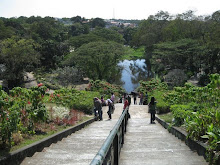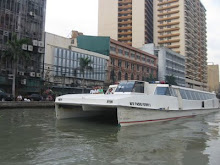The Bangui Windmills are located in Bangui, Ilocos Norte, Philippines. I think i've counted 20 windmills there, if i still know how to count that is :)
Tuesday, May 17, 2011
Thursday, May 12, 2011
ILOCOS: La Paz Sand Dunes
The La Paz Sand Dunes or Bantay Bimmaboy consists of an area of approximately 85 square kilometers (52 square miles) of protected sandy coastal desert and beach close to Laoag City, the capital of the province of Ilocos Norte in the Philippines. The area is known locally by the name Bantay Bimmaboy, a name which refers to the common perception that the dunes resemble pigs in shape.
The height of the dunes ranges from 10 to 30 meters. The dunes themselves are scenic but a panoramic view of the South China Sea can also be seen from them.
With its dramatic landscape, the La Paz Sand Dunes is a popular site for shooting local and foreign films. It was used as a location for the Philippine movies Himala and Panday and for segments of the Hollywood films Mad Max and Born on the Fourth of July. A few people inhabit the area, as can be seen from the nipa huts that dot the dunes.
Source: http://en.wikipilipinas.org
Wednesday, May 11, 2011
ILOCOS: paoay church
Paoay Church (also known as the St. Augustine Church in Paoay) is a historical church located in Paoay, Ilocos Norte. During the Philippine Revolution in 1898, its coral stone bell tower was used by the Katipuneros as an observation post. Paoay Church is part of the UNESCO World Heritage List. It currently is a property of the Diocese of Laoag, Ilocos Norte. Construction of Paoay Church was started by the Augustinian friars in 1694. It was completed in 1894 led by Fr. Antonio Estavillo and was re-dedicated in 1894.
A three-storey coral stone bell tower stands a few meters away from the church. The bell tower served as an observation post in 1896 for the Katipuneros during the Philippine revolution against the Spaniards, and again by the Filipino guerillas during the Japanese occupation in World War II.
According to historians, the bell tower also served as a status symbol for the locals. The bell would ring more loudly and more times during the wedding of a prominent clan than it would during the wedding of the poor.
Portions of the church was damaged during the earthquakes in 1865 and 1885. During an excavation inside the church in 2000, a prehistoric human skeleton and fragmented ceramics were discovered and are now in display at the National Museum. Former president Ferdinand Marcos declared Paoay Church as a national treasure and is now included in the UNESCO World Heritage List.
The Church is a unique combination of Gothic, Baroque and Oriental designs. Its facade reveals Gothic affinity, its gables show Chinese elements, while the niches topping the walls suggest Javanese influence (reminiscent of the famous Boroboudur Temple).
Known as the “Earthquake Baroque” church in the Philippines, Paoay church was built of baked bricks, coral rocks, salbot (tree sap) and lumber, and has 24 carved massive buttresses for support. It is an architectural solution to the area's challenging, natural setting. Both sides of the nave are lined with the most voluminous stone buttresses seen around the islands. Large coral stones were used for the lower level while bricks were used for the upper levels of the church. The walls are 1.67 meters thick made of the same materials. Its bell tower, which is detached from its main building, is made of coral stone. It stands a safe distance away to spare the sanctuary in case of collapse. Originally, the church roof was thatched; and it is conjectured so that buttresses not only support walls but give roof access during fire and typhoon.
The rectangular facade of the church is supported by four pillasters which extend from the first to the second level outlining the arched doorway. Huge volutes or buttresses and low-relief lines are found on each side of the facade.
In Fr. Pedro Galende's book, he described the massiveness of the structure is balanced by its grace and fluidity. The church adapts the pyramidal design of the baroque style. Its details are inspired from by seal of Saint Agustine, the emblem of the king of Spain, the logo of the Pope, the “init-tao” or the sun god, and stylized Chinese clouds.
Source: http://en.wikipilipinas.org/index.php?title=Paoay_Church
Tuesday, May 10, 2011
ILOCOS: storebucks
found this storebucks near the marcos museum and where former presidents marcos' "waxy" remains is lying in the mausoleum.
Monday, May 09, 2011
Sunday, May 08, 2011
Saturday, May 07, 2011
ILOCOS: Vigan - Butterfly Garden at Baluarte
butterfly garden at baluarte, vigan city, ilocos sur
hatching room
Friday, May 06, 2011
ILOCOS: Vigan - Baluarte ni Singson
the mouth of one of the life-sized statues of dinosaur at baluarte ni singson in vigan city, ilocos sur. one thing i can say is that this place is really big (about 80- hectares) and it is a mini zoo, a butterfly garden, with man-made falls, and they even have a live animal show for free. wow! chavit singson must be really really rich to afford to open this to the public for free. yup free to anyone and you can have picnic inside and the rest rooms are clean! to be able to find a nice c.r. at a free public place is very rare specially in the province so big kudos to the owner. :0
Thursday, May 05, 2011
ILOCOS: Vigan - St. Paul's Metropolitan Cathedral
cathedral of vigan also known as st. paul's metropolitan cathedral
bell tower of the cathedral of vigan
the cathedral's main door
just wondering if this is a coat of arms of something? just above the main door of the cathedral. anyone enlighten me please, thanks.
Cathedral of Vigan. Like most stories of centuries old churches in the Philippines, this cathedral was first build on wood, has been on fire and toppled by earthquake but erected again on the same spot, and has been occupied by the american forces during the war.
so i guess, you could say that our churches are stubborn and strong eh? no matter how many times it goes down... it will always rise.
Wednesday, May 04, 2011
Tuesday, May 03, 2011
ILOCOS: Vigan Old Houses
Vigan Heritage Site kinda remind me of Intramuros, only here there are more souvenir items and most of the old houses along calle crisologo are stores unlike in intramuros where most of the casas are turned into fine dining restaurants. most shops sell you usual pasalubong stuff and of course ilocano delicacies like bagnet and tinubong
cobbled stone street of calle crisologo, this street i think is vigan's most photographed street. lots of calesa's plying through the streets, the motorcyles and tricycles and modern vehicles are off limits and only ply the main roads which is good.
i heart vigan shirts
cafe leona, the house apparently belongs to a distant cousin of Jose Rizal and is a young poet as read from the historical marker on its door, but its now a restaurant and read good reviews but wasnt able to dine here coz it was closed when we were there (twas black saturday)
kinda spooky staircase inside grandpa's inn, a bed and breakfast hotel at the vigan city
i just love old windows and doors, i wanted to take home with me one of those window
ILOCOS: Vigan 143
About 400 kilometers from Manila is the UNESCO World Heritage Site of Vigan. It is the capital city of Ilocos Sur located on the west coast of northern Luzon. One can see precious remnants of old Spanish architecture throughout the center of the city. Established in the 16th century, Vigan is the best-preserved example of a planned Spanish colonial town in Asia with a unique European atmosphere. Several museums exist for the many national heroes that were born here. Vigan is the oldest surviving Spanish colonial city in the Philippines. The name Vigan was derived from "Biga", a giant taro plant that grows abundantly along the banks of the Mestizo River. (Source)
Subscribe to:
Posts (Atom)
















































